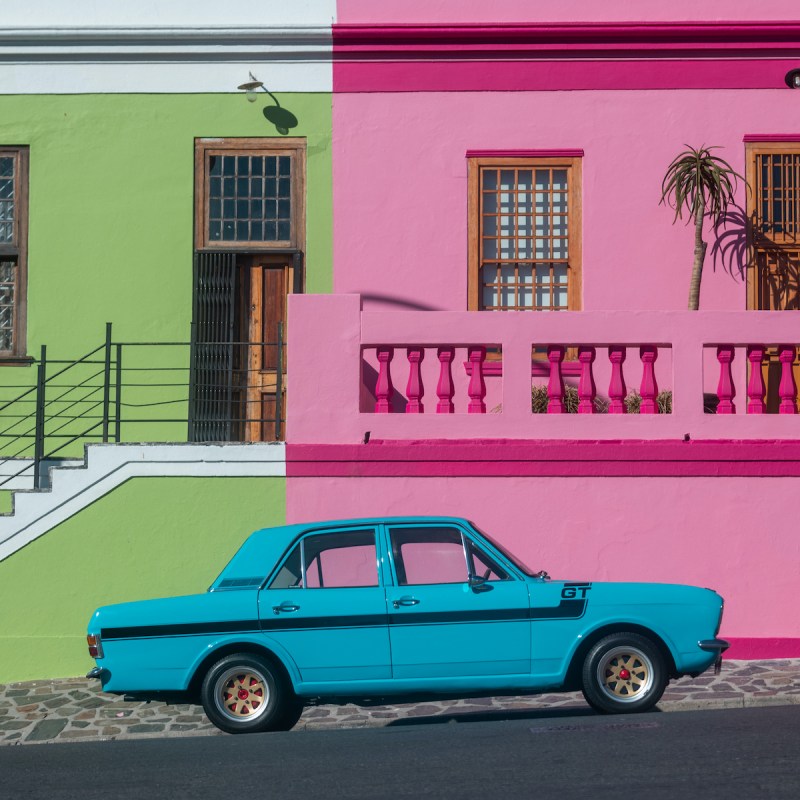
For the last installment in our series about the most colorful cities on each continent, we have reached Africa. And, as if Africa on the whole wasn’t already colorful enough, with its majestic landscapes, animals, and plants, any congregation of people usually results in further riots of color. Gorgeous, bustling, and colorful markets; patterned, bright materials being made into traditional dress; and that typical blue the Berbers wear are just the beginning. Color is all around, and often enough, more distinct pops of color from the local architecture are thrown into the mix.
Videos by TravelAwaits
Here are some great examples reaching from the north of Africa right to the southernmost point, and some in between, including a few islands, to give you a roundup of all the most colorful places and cities on this exciting continent.
I picked my favorite places, some of them cities, others parts of cities, and others natural wonders. All will make your eyes pop and make you want to pack your bags immediately.

1. Bo Kaap, Cape Town, South Africa
The neighborhood of Bo Kaap is featured in my list of the Most Colorful Cities In The World because not only is it the most colorful place on the continent, but it is also my favorite spot, period. There is so much to love about Cape Town, with color all around, but the old slave neighborhood of Bo Kaap is the best. The history of the quarter is awful, but with a quite literally bright ending: Only freed slaves were allowed to paint their house in a bright color, and the entire neighborhood eventually turned into a rainbow of colors. One of the most Instagram-able places in the city, each and every house tells a story and makes for a great photo. There is also the cuisine in this Malay area, which is as colorful and enjoyable as the architecture. Prepare to spend some time here and bring a camera.
Pro Tip: There is so much history in this neighborhood that it is best to go on a walking tour with a local who can tell you everything, and also take you to sample some of the great food.

2. Chefchaouen, Morocco
Chefchaouen is also one of the most colorful cities in the world, but not because of the myriad of colors, but because all the houses are painted a beautiful blue. This blue town, nicknamed the “Blue Pearl of Morocco,” lies at the edge of the Rif Mountains in the northwest of Morocco, and is a uniquely blue city (as is Jodhpur in India). Visitors come to marvel at the formerly white buildings that have been treated to a blue wash, and legends tell of different reasons as to why the town is blue. Reportedly, it keeps mosquitoes at bay, makes the heat of the sun less fierce, or represents the sky and the sea. But really, it is just pretty.
Pro Tip: You get quite good views across the town from the top of the kasbah, but for the best view taking in the entire blue town, leave through the medina’s east gate, cross the river, and follow the trek up into the mountains until you reach the little white mosque. From there you will really appreciate the splash of blue that is Chefchaouen.

3. Chamarel, Mauritius
Chamarel is a village in the southwest of Mauritius and would be, by itself, quite unremarkable if it wasn’t the gateway to the national parks around it. It’s also famous for its landscape that attracts visitors with its natural beauty, its wildness (perfect for adventure sports and hiking), and the region called Seven Colored Earth. Seven Colored Earth is a GeoPark with some 600 million years of natural history and is famous for, you’ve guessed it, the different hues the earth exhibits here (and it’s not all shades of brown). Here the earth makes a spectacle out of itself by showing off in red, brown, violet, yellow, green, orange, violet, and shades in between, although the actual definition of each color may well vary with whoever is looking at it.
Pro Tip: The best time to really appreciate the different hues is close to sunset, so with the park closing at 5:30 p.m., get there as late as possible and linger until they tell you to leave.

4. Gorée Island, Dakar, Senegal
As so often happens, some of the most picturesque places in the world often hide a terrible history. Gorée Island, off the coast of Dakar in Senegal and the westernmost point of Africa, has a dark slave and colonial history, which is told in the House of Slaves. Due to Gorée’s strategic position as a trading post, the picturesque island with its prettily colored buildings has been fought over by the Europeans since the mid-1400s. The Portuguese, Dutch, English, and eventually the French all vied for control. Today the island is listed as a UNESCO World Heritage site and is a thriving art hub full of artists and markets where you can buy their works. Its colorful art, houses, and markets stand in stark contrast to its dark background.
Pro Tip: Take a short boat trip from Dakar to the island and enjoy a view of the coastline.

5. Pink Lake, Dakar, Senegal
Just down the road lies a superbly colorful spot: The Lac Rose, or “the pink lake.” Pink because of the bacteria that produces red pigment to absorb the sunlight, the lake also has a high salt content, up to 40 percent in places, which makes it comparable to the Dead Sea. During the dry season, it even exceeds the Dead Sea’s saltiness. The salt is harvested by workers along the coast of the lake, but there is also a beach club and restaurant popular with people bathing in the salty lake, as the bacteria are completely harmless to humans. It is the perfect natural pop of color, especially when contrasted against the white of the salt hills piled up alongside the lake.
Pro Tip: Whether you are based in Dakar or in one of the resorts along the coast, many day tours combine the pink lake with a trip to the lovely Bandia Nature Reserve where you can marvel at gigantic baobab trees and a huge selection of African animals living in a protected environment.

6. Antananarivo, Madagascar
Capital of the Indian Ocean island of Madagascar, Antananarivo is a suitable capital for an intriguing and diverse island. This capital does not just deserve an entry into the selection for most colorful places in Africa because of the eclectic and brightly colored houses that crowd the side of the hillsides, but also because Tana (as the capital is conveniently abbreviated to by locals) has managed to bring together the various tribes and ethnic groups of this large island and rule despite and because of the diverse mix. Color in Tana comes from the houses, its art, the markets, the people, the history, its cosmopolitan cuisine, and varied spices.
Pro Tip: You cannot possibly visit the capital without seeing at least some of the island, best explored by tours, if only because of its size.

7. Bathing Boxes, Muizenberg, South Africa
The small town of Muizenberg on the Western Cape in False Bay, some 16 miles from Cape Town, stretches between the mountains, a road following the bay, a small rail track, and the beach. Muizenberg means “Mouse Mountain” in Dutch. It sounds busy, but it is not, and indeed is quite picturesque. What makes Muizenberg more famous than its little restaurants and bustling beach community are the bathing boxes, which are rather colorful. Many communities around the world have them, but they are no longer as popular as they were in the Victorian era, and every remaining example is always worth stopping for. These offer a lovely color splash against the blue water of False Bay.
Pro Tip: Because of the sheltered environment of the bay, the water here is warmer than further south and is ideal for water sports. Why not learn to surf?

8. Sidi Bou Said, Tunisia
Looking at pictures of Sidi Bou Said in Tunisia, you would think you are looking at Santorini in Greece if you didn’t know any better. White buildings set against the blue Mediterranean, shimmering in the sunlight, and with blue doors throughout, make it a photogenic and instantly relaxing location. The doors are the same blue as those Berber robes and are wooden, but enhanced by wrought-iron décor. Add green branches of Bougainvillea with pink flowers creeping on the houses and you have a colorful place that personifies the beauty of the Mediterranean. This is probably why so many artists and writers visited this place for inspiration: From Flaubert, Chateaubriand, and Simone de Beauvoir, to Matisse and Klee, they all loved this town.
Pro Tip: Stay at the small boutique hotel Bou Fares for the full immersion into Sidi Bou Said’s white and blue experience.

9. Sal Rei, Boa Vista, Cape Verde
Cape Verde, or “the green cape,” is an independent archipelago of around 10 islands in the Atlantic Ocean, roughly 350 miles off the western African coast. Boa Vista, meaning “good view,” is the most easterly island, and its capital Sal Rei, home to half the population of the island (12,000 inhabitants), is a quiet little town. While surrounded by white beaches and the blue ocean, there is also a lovely colorful array of painted houses, particularly down Rua de Bom Sossego. The cobbled street is shaded by trees and lined with low-rise pastel-colored buildings that once again hark back to a colonial past.
Pro Tip: The jury is out on which is the best island in Cape Verde, with each having something special to offer, so why not indulge in some island hopping when there?

